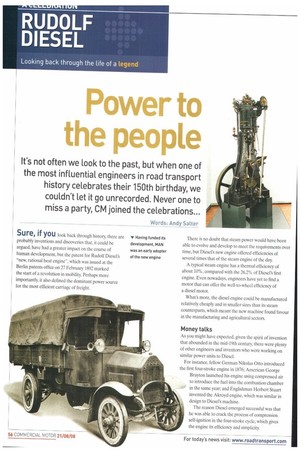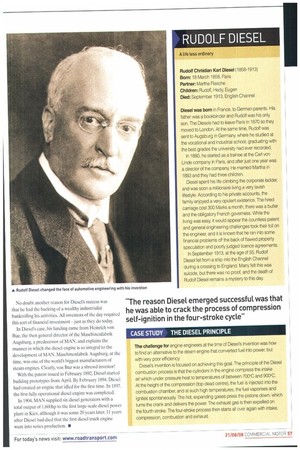1 .0 0wer t" fh.oeoi .. atilk 111 11 0 ,
Page 56

Page 57

If you've noticed an error in this article please click here to report it so we can fix it.
It's not often we look to the past, but when one of the most influential engineers in road transport history celebrates their 150th birthday, we couldn't let it go unrecorded. Never one to miss a party, CM joined the celebrations...
Words: Andy Salter Sure, if you look back through history, there are probably inventions and discoveries that, it could be argued, have had a greater impact on the course of human development, but the patent for Rudolf Diesel's "new, rational heat engine", which was issued at the Berlin patents office on 27 February 1892 marked the start of a revolution in mobility. Perhaps more importantly, it also defined the dominant power source for the most efficient carriage of freight. There is no doubt that steam power would have been able to evolve and develop to meet the requirements over time, but Diesel's new engine offered efficiencies of several times that of the steam engine of the day.
A typical steam engine has a thermal efficiency of about 10%, compared with the 26.2% of Diesel's first engine. Even nowadays, engineers have yet to find a motor that can offer the well-to-wheel efficiency of a diesel motor.
What's more, the diesel engine could be manufactured relatively cheaply and in smaller sizes than its steam counterparts, which meant the new machine found favour in the manufacturing and agricultural sectors.
Money talks
As you might have expected, given the spirit of invention that abounded in the mid-19th century, there were plenty of other engineers and inventors who were working on similar power units to Diesel.
For instance, fellow German Nikolas Otto introduced the first four-stroke engine in 1876; American George Brayton launched his engine using compressed air to introduce the fuel into the combustion chamber in the same year; and Englishman Herbert Stuart invented the Akroyd engine, which was similar in design to Diesel's machine.
The reason Diesel emerged successful was that he was able to crack the process of compression self-ignition in the four-stroke cycle, which gives the engine its efficiency and simplicity. No doubt another reason for Diesel's success was that he had the backing of a wealthy industrialist bankrolling his activities, All inventors of the day required this sort of financial investment just as they do today.
In Diesel's case, his funding came from Heinrich von Buz, the then general director of the Maschinenfabrik Augsburg, a predecessor of MAN, and explains the manner in which the diesel engine is so integral to the development of MAN. Maschinenfabrik Augsburg, at the time, was one of the world's biggest manufacturers of steam engines. Clearly, von Buz was a shrewd investor!
With the patent issued in February 1892, Diesel started building prototypes from April. By February 1894, Diesel had created an engine that idled for the first time. In 1897, the first fully operational diesel engine was completed.
In 1904, MAN supplied six diesel generators with a total output of 1,600hp to the first large-scale diesel power plant in Kiev, although it was some 20 years later, 11 years after Diesel had died that the first diesel truck engine went into series production. in












































































































































































